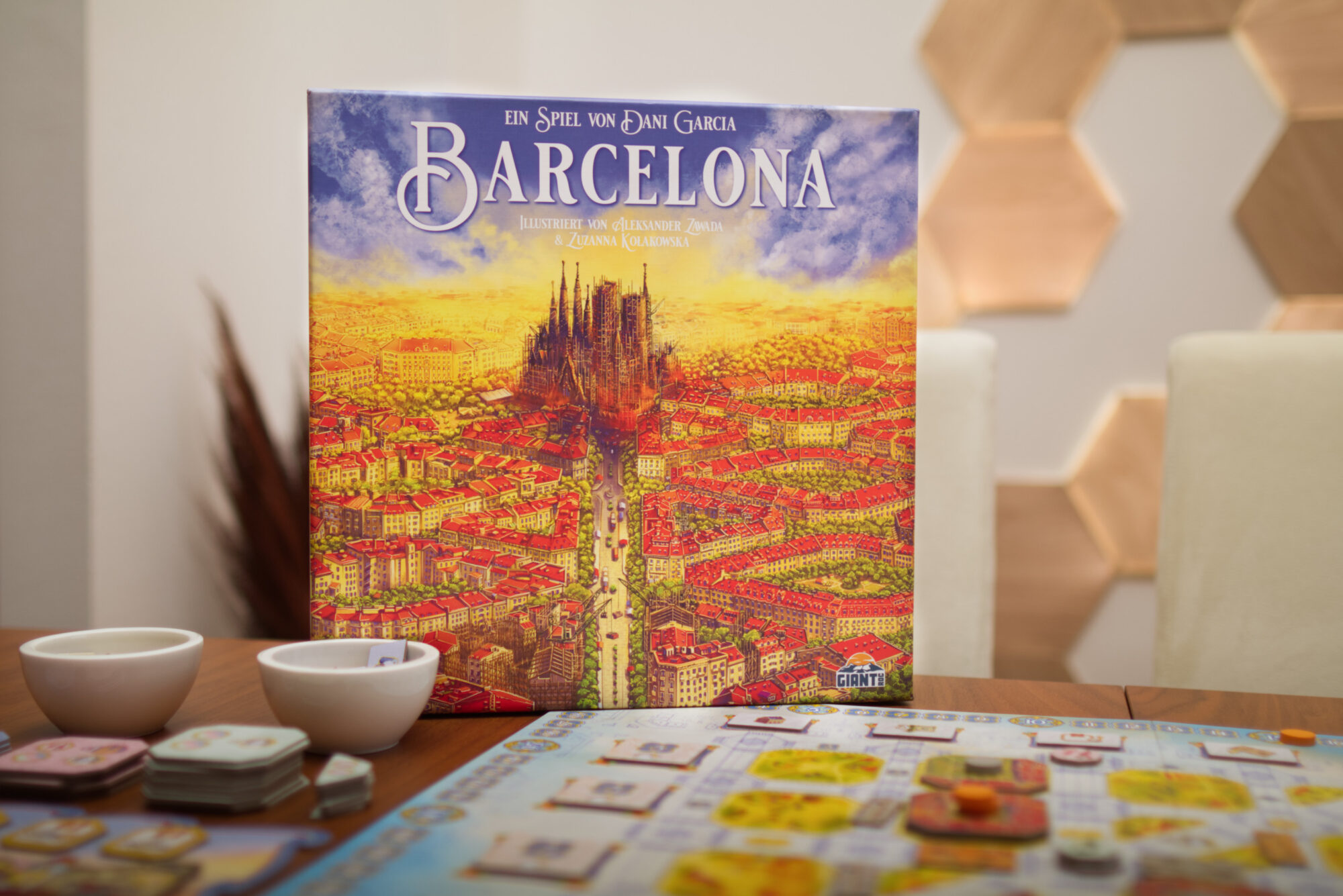This is part 2 of my conversation with Dani in which we are talking about prototyping digitally in Tabletop Simulator, balancing, the eventual release of Barcelona, and of course designing the expansion Passeig de Gràcia.
If you haven’t read part 1, you can find it here.
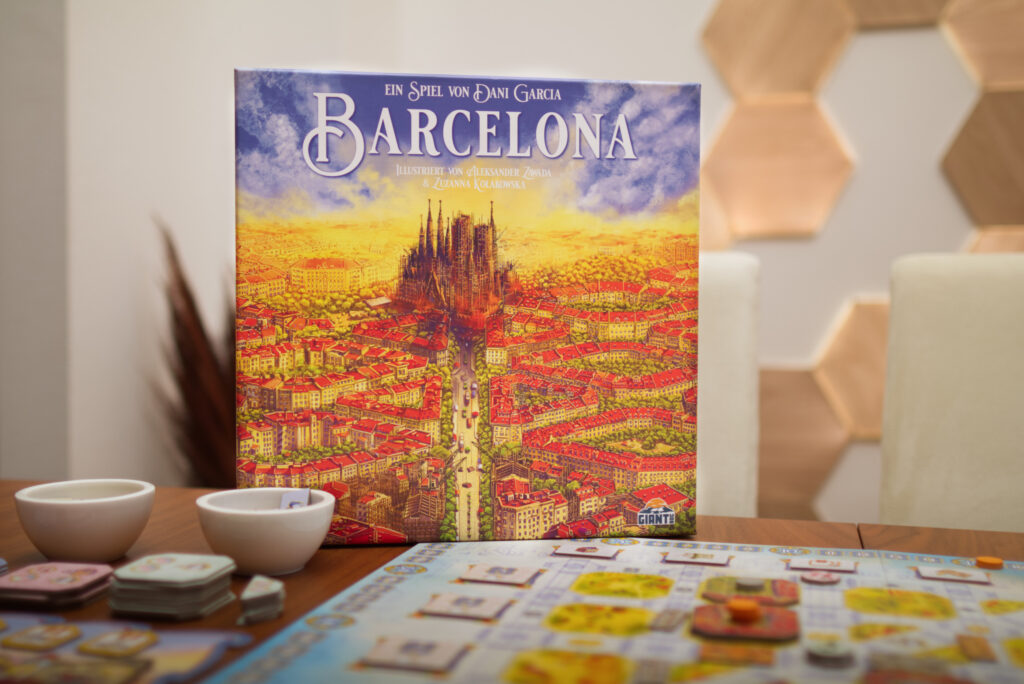
Playtesting & Solo Modes
Earlier, you mentioned TTS. Do you have certain techniques how you playtest a game?
Yeah, and I’ve been refining that over the last years because obviously these four or five years, I’ve gained a lot of experience. So now I do feel that I have a very specific method. Even if I don’t have some rules that I follow, just internally, I always do it the same.
I only work on TTS because amongst other things, I’m terrible at doing physical prototypes [Alex laughs], but extremely terrible. I showed Barcelona to one publisher and I printed it with a much smaller size and it was like playing “Tiny Epic Barcelona” [Alex laughs even harder] or something like that. It was ridiculously small and also it was paper, it was terrible to print. So I’m not good at that and it’s also much harder to find playtesters and playtest continuously if you have to meet and you have to find free time. I found that obviously the pandemic helped a lot with that because a lot of people went to TTS and now they are fluent with it. So now I always do it there.
I start with an idea in my head. Once I have the whole game in my head – obviously it won’t work, but I need to have the idea of how everything will work [in general] – I will create the prototype on TTS and I start trying it myself, playing a few turns and see if there’s something completely broken or if it more or less holds. Then I start doing tests with people and on those tests I never play. I just explain the rules and I help them move things because TTS is much slower, so I just help moving things and speeding up the tests. Obviously I hear their feedback and I take notes. One thing I like to do is once I finish the test and I have feedback, I immediately do changes. So I don’t have three or four sessions of feedback and then I decide to change things because if something doesn’t work on one game, it won’t magically be solved on the next one. So I think that’s also part of the reason why it doesn’t take me that long to reach a point where the game is, let’s say, finished. Because every playtest, I do changes and obviously with experience, every time I’m faster in finding a solution for the problems. But yeah, I keep doing that. It’s just a process of repeating at this point until the game is more or less finished and I can start showing it to publishers.
Then at some point I will do the solo mode, which also helps me to play the game myself because many times until the solo mode, I have not played the game. I’ve just seen people play the game and I make decisions based on what they do and what they tell me. But yeah, the solo mode is the last moment where I test the game myself and I see how I feel. I’m not just adjusting to solo mode, I’m also doing the final touches on the game. Then [there is] whatever feedback you get from the publisher. If they gave feedback before, I will go back and do more playtests and then give them back [a new version]. Once you start working with the publisher, the process may change a bit depending on the publisher, but that’s pretty much what they do with every game.
Now, I have so many games at once that I’m doing that but [in parallel] with others. So I do a playtest of one game, I take notes of the changes, then I do a playtest of the next one while I’m doing the changes of the first one. So it’s not as smooth as it was before, but it’s the same idea.
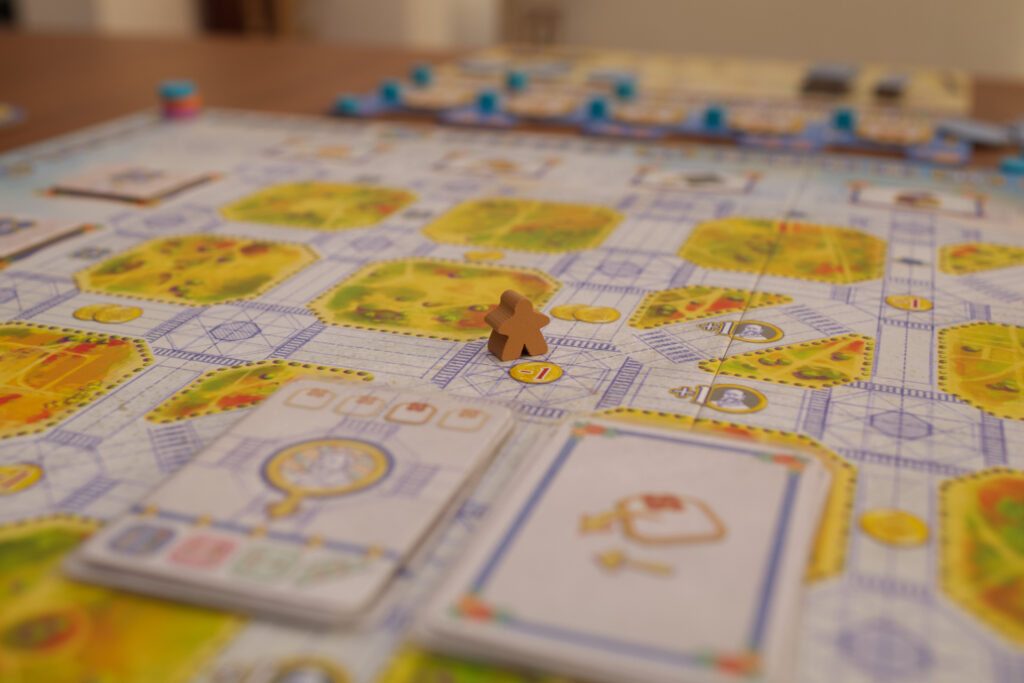
I think you’re the first designer I talked to who actually uses the automa during balancing. I’m always wondering why not more designers do it.
I do play solo games and some designers don’t, so it’s easier for me to do it. But yeah, sometimes if I feel that the game was maybe not working exactly and I couldn’t solve it with tests with people, I’ve done half an automa just so I don’t have to play as two players which is really brain-burning. Because if I try it when other people are playing I cannot focus on what I’m doing and I cannot focus on what they are doing. It doesn’t work for me. So I sometimes do it with half-baked automa and sometimes if everything has been working fine, I do it with the final version and then also try to create the final version of the automa at the same time.
I found this post where David Turzi said “by the way, just so you know, I said [to the publisher] I couldn’t do it any better, keep Dani’s Automa”. How did that feel? I mean David Turzi is one of the main Automa designers out there.
[Dani laughs] Yeah. And I [learned of] it from the same post, they didn’t tell me! It was very nice. I knew that they had worked with David, but I already had an automa so I assumed they would just go with my automa. I guess they have a lot of trust in him and they wanted his opinion, so it was great. I’ve met him after that and he has told me that, well, he’s not happy that I’m not giving him business [both laugh] because I’m always doing the automas. But yeah, it was great to have that kind of feedback and he’s always been very supportive of me in general when we have talked.
Balancing
There have been conversations about whether or not the starting player has a disadvantage? What’s your take?
Yes, [I saw] those posts. In fact, at some moment there were two threads, one saying the first player had an advantage and the other saying the last player had an advantage. At some point I replied to the post that said that the first player had an advantage. First [let me say], I cannot be 100% sure because in this case Board & Dice did the final playtesting and balancing of the game. I know them and I know how they develop, I trust that they have done the testing and that they are correct. I also think that they are correct, but I cannot say 100% for sure because I was not involved in this last part of balancing. That being said, I think the difference is that if you’re first player, you have to play a bit different. It’s not that you have a disadvantage because people are saying, okay, you cannot build on your first turn, this gives you a disadvantage and you’re always behind in building, so you have one building less. But that’s not that many points by the end of the game where you can do 300 or even 400 points. That small difference, it’s a difference, but it’s not that big.
In opposition to that, you have the advantage of choosing the first move. And you’re always one turn […inaudible…] in all the Cerdà scorings. So for me, Barcelona, it’s a game where when you set up the game, you have to read the board. You have to see where the actions interact, what scorings there are, what public services there are. Because there’s usually one or two very good starting spots. And I used an example on that post I did where if you have certain combinations, you can place three intersections on your first turn. And by your second or third turn, you could have all of them, which basically means you have pretty much an infinite resource generation engine already done.
So there are very good first moves if you can see them. And I think if you’re a first player, you have to use them in order to use that advantage. You don’t have the advantage when building, but you have this advantage. And I imagine… I won’t say it for sure because maybe I have not done the test and maybe there’s really a disadvantage but I think when people complain about it, they only focus on the building part and they don’t see that there might be very big moves that you can really use in your advantage on that first turn.
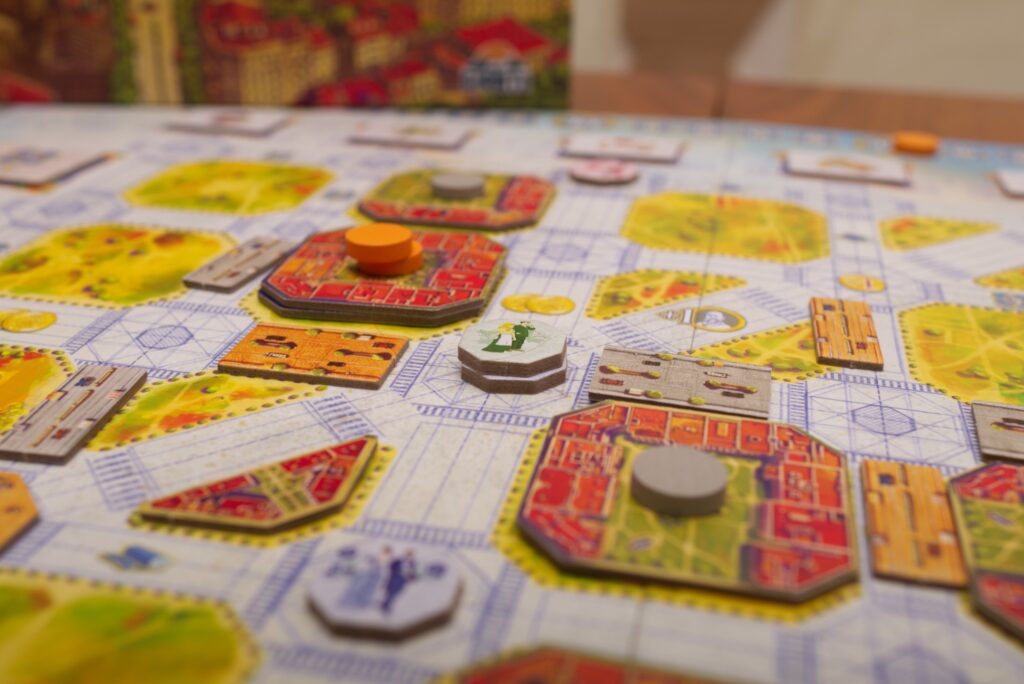
It’s funny that you mentioned it, I wanted to also ask you specifically about the intersections. I always struggle with them myself. I felt they are not worth it and now you mentioned one can push them out so quickly. Do you have a tip for me? How I can use intersections correctly?
Yeah. Well, I think two things happen with the intersections. With the actions as printed on the board, they are on one of the edges. I think most people play their first games without randomising the actions, which I think is a mistake. I would always recommend to randomise the actions because that’s the point of the game for me. And if they are one of the actions that are on the edges, they are less powerful because they are harder to do and you will do them less often. That’s one thing that happens. The other one is most people forget that when you place an intersection, you get the rewards of all the streets that are [adjacent to them and yet uncovered]. I’ve seen a lot of videos where people don’t take those rewards.
If you just place them and hope for people to jump on them, they are not as powerful. But especially if you can get three or four of them early on, you can place them on places where you want to go. It doesn’t matter if others want to go there; if you want to go, you will get the benefits. They become really powerful because every time before you do your action, you can get two resources or even at some point move up on the Cerdà track if I’m not wrong.
You can get a lot of resources from them, plus all the resources you got by getting all the connections before they are covered with streets. So they are better at the beginning of the game, basically. If you can build a lot of them early on, they can be really powerful. That will be probably my tip.
I have to give it another shot now.
Release & The Expansion
Let’s jump into the more recent times. Tell me about what the reception of Barcelona was like for you.
Well, it was great. It was not my first game because Arboria happened first. But it was the one that people were [receiving first] because Arboria was on Kickstarter and it was released a bit later. It was great to see the reviews, but from your own home you only see basically the BGG ratings and some comments on the forums. Obviously it was really good when you hear certain content creators like Rhado talk a lot about the game and talk really [positively].
So I think most of my first experience came from me constantly refreshing the ratings. [Alex laughs] I think that most of them were good. Also early on – I think it was even before the game was released – Board & Dice already asked me if I wanted to do an expansion. So I thought, okay, they think that it’s going to [do well]. It was a process of being probably a bit too obsessed because obviously you may have lot of 8s and 9s on your ratings and then suddenly there’s a 1 and you think “why is there a 1?”. You only focus on that 1. [Alex chuckles] But yeah, with time seeing more and more reviews and that most of them were talking positively about the game was really nice. I mean I was happy with the game. I thought that the game was good, but obviously you don’t know how many people will like it and if it will have success or not.
But yeah, at some point I remember there was a video of the Dice Tower with “top upcoming designers” or something like that and I ended up appearing on two of the lists. So, yeah, by the end of the year I was very happy with the results and I was more relieved of this adventure that I had started by leaving my job and only working on this because I thought, okay probably I can leave of this if this one is going as it seems to be going.
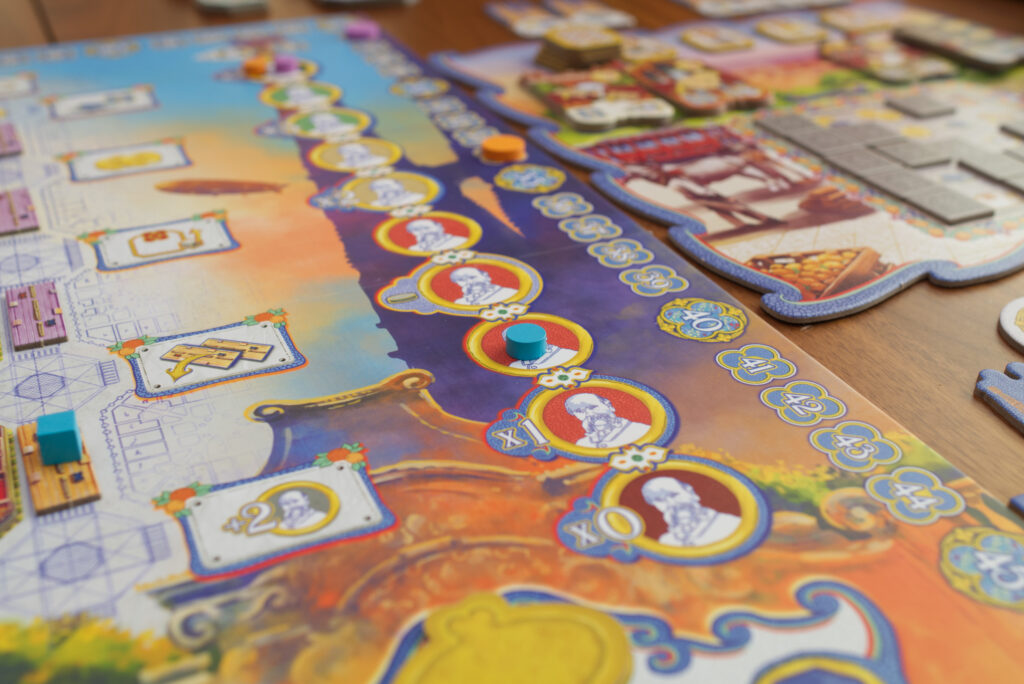
Have you reached the point with Barcelona, Arboria and all your other games that you now can actually say, “okay, I’m safe, I can live off them”?
I will know it next year. [Dani chuckles] For most companies you get the royalties by January and you get the royalties of the previous years. So right now I only got Arborea and Barcelona but only the last part of the year. So now I don’t know how all the games of this year are working and I don’t know what it means to have an expansion or the reprint of Barcelona. So I don’t know exactly what those numbers will be. I think I will be able to sustain myself but I still don’t know it for sure. But a lot of designers that have more experience they are telling me that yeah you will do fine. So I have to trust them.
I have no details of the industry but I would say so myself: yes, I think you will do fine!
It’s also because I had that luck that I was able to say, okay, I will be not earning anything for three or four years so I can just work on games. And then when they start releasing, there will be two or three every year. So if I didn’t have that luxury, I would probably not be able to sustain myself. So I think that’s why it’s difficult to be a full-time designer. It’s not because you cannot do enough money, it’s because you need the time to design three or four years in advance in order to start the wheel moving.
Barcelona must have done well. I think it is quite unusual for a publisher to say “let’s do an expansion” nowadays. And I know some designers don’t even like to do them because they say it’s as much work as designing a new game.
For me it wasn’t actually. It was really quick to do the expansion. I guess it’s because of what I said in the beginning that now I need a theme [to design a] game. If I designed the [base] game, I already know the theme a lot. If they ask me, can you do something else? Maybe I might struggle to find something else to do. But once we have this idea … for example, with Barcelona it was, OK, let’s do it with Passeig de Gràcia, which was the most iconic street of this part, then the ideas started flowing quickly. If I’m not wrong, I did two play tests. So I did one play test, I showed it to Board & Dice, they gave me feedback, I did another playtest, I give them to Board & Dice and they said, okay, we take it.
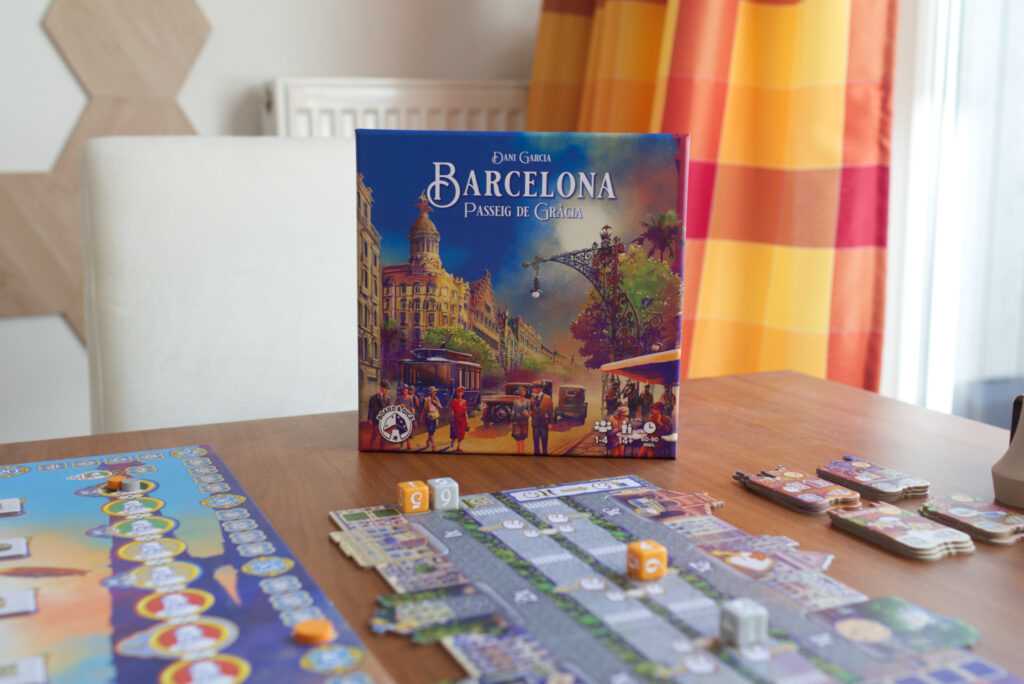
Wow!
So it was really quick. Then they did their testings and the process continued. But yeah, it wasn’t that long to be honest. I’m not sure if all expansions will work this way, but that one was really, really quick.
No, it’s really unusual and impressive.
Yeah, I guess it’s this because I already know the subject really well and I had the idea about the Paseis de Gràcia. Again, I just researched it and there were a lot of thematic ideas about what was there on Passeig de Gràcia and what it is now. So I could easily find mechanics that fit those ideas and it was quick to do.
Did Board & Dice give you any design limits like it has to fit in the base game or it can only cost 20 Euros?
No. I think I asked them and they said something along the lines of “you’ve seen all kinds of expansions we do, so check our other products. We have some that are very small, some that are bigger, so anything that’s inside that range, it’s fine.” So no, they just gave me complete freedom.
And did you have any particular goal with the expansion that you wanted to adapt something from the base game and make it better or was it just like I wanted to add something?
Well, I wanted it to feel like it was part of the same game and I also wanted it to be an expansion that didn’t add too many rules and once you played it you usually don’t want to play without the expansion. So it’s not one of those expansions that is a lot of complexity and then you only can add it if everybody knows the game and if they are in the mood.
Barcelona basically is a sandbox. You can do any actions you want and you only value them depending on if you have certain things that score them, more or less. That changes how actions are valued in each game. So I wanted to reinforce that and give a different direction, push you in a different direction again on wanting to do one or the other action.
So I came up with this idea of having the actions with a multiplier next to them, because I also like to multiply things in general. I don’t remember exactly the first idea, it was different. You had to have done the action that many times, but then something different happened, I don’t remember. But the core idea was there, but what you did, I think, was creating too many combos or it was too complex or something like that. But then the second idea I already went with on this direction. And it’s basically what you’re doing is you’re assessing how many times you have done certain actions in the game. And if you have done the ones that you need, you will get more rewards. So it’s telling you, you want to do this action one time, this one two times, this one three times. But then you also want to do this Cerda scoring. And then you also want to do this one of your own scoring. So basically, it’s just giving you another path to do to score points.
And because the movements are integrated in the grid, you will sooner or later – even if you say you want to ignore the expansion – sooner or later you will start moving your pedestrians [whether you] like it or not. Or sooner or later you will say, well, I already have done this action once and this action twice, so why not to use it? So I wanted it to be something that it could not be avoided, let’s say. It could not be something that, yeah, there’s a mechanism there, but I can ignore it and just play the regular game.
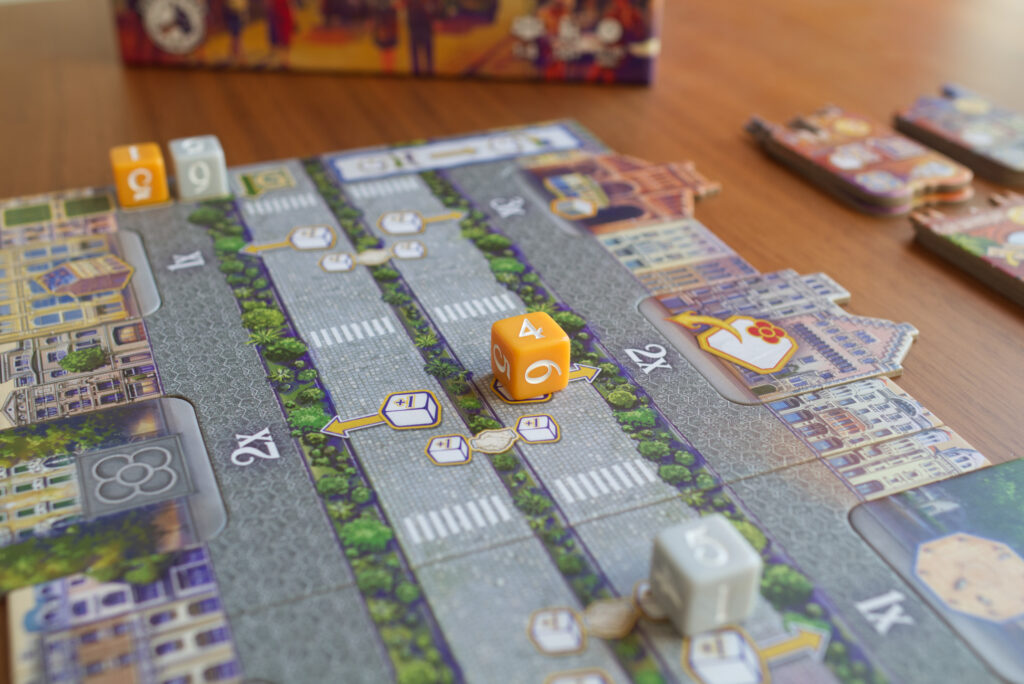
Do you think a no-Passeig strategy is viable?
You can decide you don’t want to do it and you can force it not to do it. But I think you will be causing problems to yourself because just by playing at some point you will have done the first action one time and maybe the second or the third action two or three times. You will be in a spot where I want to do this action, it crosses with the action that move me the pedestrian, so why not do it? Even if I don’t reach the end with a high number, I will get some points. So it’s a valid strategy, but then you realise that it’s not that hard to reach a four value on the die. You need to have two of the things completed and then meet with the other of your dice and you’re already at four. And that already lets you place a tile that – depending on what you’re doing – can also give you a lot of points or lot of resources. Again, it’s another way to find that action that you want to do or those resources that you’re looking for. The game just gives you another way to get them, another way to feel smart about it. So I think it’s, yeah, you can decide not to do it because you want to prove a point, but if you want to play well, there’s no reason to avoid it.
My favourite detail about the expansion is that if you two pedestrians meet, they get happier. [Dani nods] Why did you put that in there?
This was because of the theme! Because that street was really used as a promenade. So it was full of people, it was full of theatres, it was full of amusement parks and people went there just to have fun. And this was even before the expansion of Barcelona started. Originally it was just the path that connected Barcelona and Gràcia, which were different towns. Now they are all part of Barcelona. And so, yeah, people went there just to enjoy the amenities and to meet other people. I’m not sure, but I think it was from there from the beginning that you had those two dice and they had to check things on the tracks but then I thought, okay, if they meet, what happens? Well, we can do this, symbolize this part of of the fact that you want to meet with people and have fun.
For us it was like surprisingly satisfying. While playing, we were always like, okay, let’s do one move here so they can meet again and maybe this way they can meet two times.
And sometimes you have moments where, okay, this one is at four but if I loop this one twice, it will get to six just by staying there. It also creates nice strategies, that’s a nice bonus. But I think the main point of that was that it was part of all the information that I got while researching it.
The other element I found very interesting is the expansion does something that a lot of games do nowadays: they give people goals. Before it was, okay, you have the Cerda scoring, but now it’s like, everybody sees it and says, the first step is I need an intersection. And suddenly people get incentivized to actually build an intersection. Was it also something you were aiming for, like forcing people to try new things?
Yeah, because as you can do anything you want, what makes you decide can be the Cerda scorings or can be the personal scoring that you will score at the end of the game. So having one extra thing that’s telling you, okay, you were not going to do public services, but now if you do two of them, you will get a bump. It’s also a way to give – not only to give options, but also if you want to do this action, but it’s not crossing with any of the other actions that you wanted for scoring, but it’s crossing with this action that works on the Passage de Gracia board …
That was the idea, trying to give more options and push players in different directions. That I want to do this action for this scoring but I also want to do this action so I can just get one more upgrade of my dice so I can get the cobblestone. It’s giving players not only more options but making decisions more interesting because you have to choose between more things.
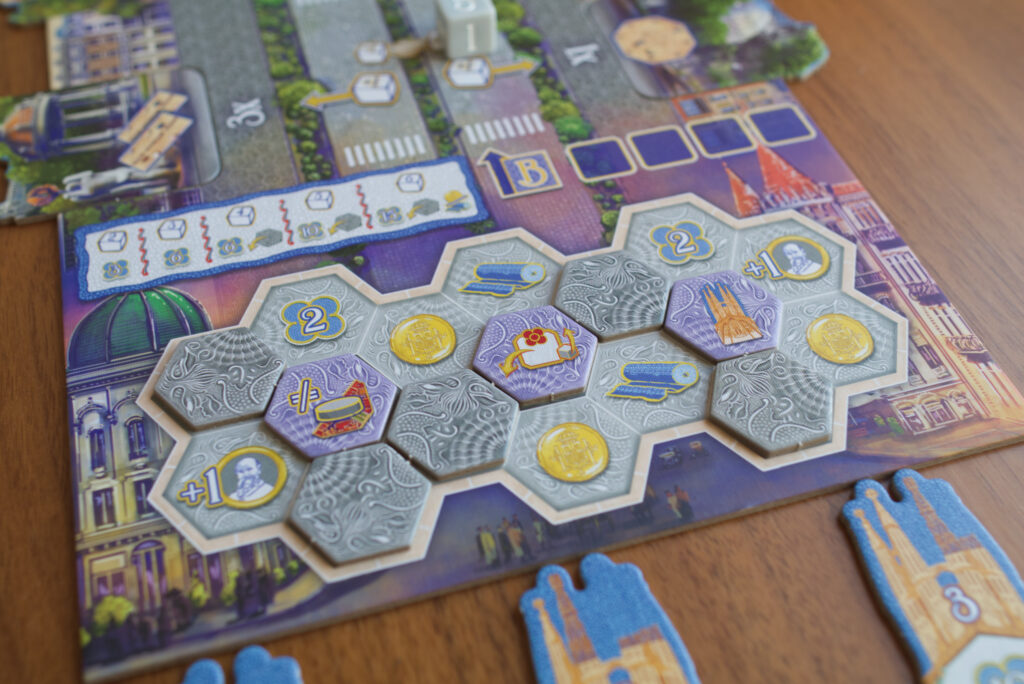
Part of the reason why the expansion is so easy to integrate is because you already had the action tiles and the variable setup in the base game. When you designed the base game, were you already thinking about potential expansions or was it just luck?
No, no. Usually when I’m doing a game, for me that’s the game and it’s completely finished. It was only when Board & Dice asked me if I had ideas that then I started to try to find ideas. And yeah, this time having those tiles was great because we had some of them that were more boring, let’s say, like get to coins, get clothes or move on the Cerda track. So we had room to add new tiles. In this case, it was lucky, or if that was not the case, I would have had to think about something else. But I wanted the expansion to be activated in the same way as the base game, by just placing workers and doing the actions. I didn’t want the next step and then after building you can move your […inaudible…] or something like that. So yeah, that part was probably a bit lucky.
You basically just answered it, but do you think there’s still space for another expansion?
I don’t know. [Dani laughs] If Board & Dice asks me to do one, I will try to think about it. But at some point … even if I like a game, if they start releasing expansion after expansion after expansion, at some point it’s just way too much. Most people nowadays, they play games a few times and they go to another one and if you release an expansion they will play it a bit more but then they jump to another one and maybe go back from time to time. But if you go back to a game and you have to read the rulebook and then the first expansion and then the second expansion … at some point it’s way too much.
If Board & Dice ask me to do an expansion and they say we see potential here I can think about it, but I don’t want to reach that point where people feel that it’s just an expansion just to generate money and that it’s not adding anything to the game.
Wrap Up
Yeah, makes sense. Maybe to wrap this up and come to a close, do you have a favourite anecdote or vivid memory from playtesting where you saw people playing it and you suddenly you were like, this will actually work or you saw something where someone completely surprised you by the moves they did?
Well, I had maybe the opposite, which is some games where a player was doubling the scoring and doing 500 or 600 points. [both laugh] And at that point you say, OK, that’s maybe way too much and you have to control things. I think this happened with Barcelona, this for sure happened in Arboria when I was doing the mini expansion of the Kickstarter. I had a game where somebody did 700 and something points, then another one 400 and something. So yeah, that’s when you realize that you have something broken in the game.
Besides that, sometimes they came up with some strategy that breaks the game and you had not thought about it, obviously. But that’s great because that’s what they are there to do, to break the game and then so you can make solutions to those edge cases. And yes, sometimes you find somebody who’s playing much better than the others and it’s the other player saying, okay, can we stop now because he’s just doubling us? [Alex laughs] You have those kinds of moments. For me, it’s not all the clever actions they do or the results that’s something that I hope can happen because I try to create games that allow people to do that. When I playtest, I’m more worried about if something is broken or if nobody is using a certain action or something is not working. So I’m more focused on that kind of thing.
Do you have like a favourite small detail in Barcelona, like either in the production and the graphics or in the mechanisms?
Sure, many things. I mean, the fact that it’s about Barcelona! Once I saw the art and the final production, it really felt like it was from that city. Even some small details, like there’s a small landscape seen on the secondary board, the one that has the cobblestones. And I thought, yeah, this could be a view of Barcelona. Even if it’s nothing specific, this could be part of the city. So it’s probably seeing the overall production and seeing something that was really ugly in prototype, with just names and cards and borders and just to show there’s a card here, there’s something here, and seeing like a finished product, I think that that was really great.
I don’t remember one specific thing because everything remind me of the city. It’s not like, okay, I added this small Easter egg that I like a lot. It’s the whole city and the whole game about something that I liked. So it was pretty much everything.
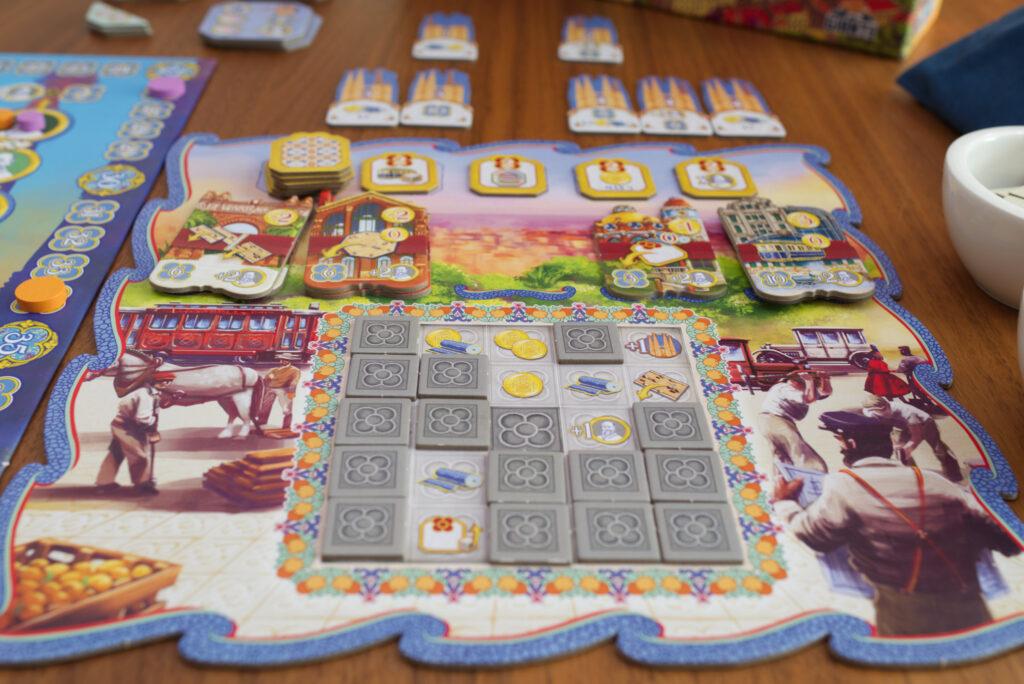
Something I ask every designer is: do you have a tip for players of Barcelona? Like what they might be doing wrong or something they haven’t tried yet?
Well, one for sure is: randomise the action tiles, even from your first game, because this changes the game completely. And I’ve seen posts on forums that I’ve played the game three or four times, maybe now I will start randomizing them. I think, no, the point of the game was to randomize the tiles from the beginning. And the other thing I see a lot is what I’ve already said about the intersections, that people think that they are not powerful enough. In part, I think, because most people forget about the rewards you get when you place them. But yeah, I would say that gives them a chance.
Nice. Final question: besides Barcelona, what are you currently excited about? Is it a certain project you’re working on?
The problem when you release games is that the ones that are releasing now I did two or three years ago. [both laugh] I like them a lot, obviously, but now I’m excited about the ones I’m doing. And right now I have to start two new games, so I have the ideas and I’m still in the process of getting more ideas and writing them down and eventually creating the prototype. And there are two other games that I have that I just want to do a game about this [topic]. I have a few ideas noted, but I cannot do everything at once, so I will hopefully do them later. So those are probably the ones that excite me the most because it’s always the next thing that excites you the most.
But I’ve hinted before that I’m now working on a game, it’s one that is already done, and I’m trying to find a publisher for it. It’s about something that’s also very close to me. It’s a Catalan tradition. And again it’s similar to Barcelona in the sense that it’s something close to me and that I know a lot about, that’s probably one of the most special ones that hopefully will come in the next years.
Fingers crossed, I’m looking forward to it.
This concludes the interview. We talked for close to two hours and turning it into a readable piece wasn’t easy but lots of fun. As always, I applied some editing and cleaned up phrasing for better readability. Any mistakes are likely mine as editor and not Dani’s! Once again many thanks to Dani for taking the time to sit down with me. It was a lot of fun getting to know him and talk in detail about Barcelona.
If you are interested in Dani’s work, check out my first impressions on Barcelona as well as the ones on the recently released expansion “Passeig de Gràcia”. For SPIEL Essen 2024, Dani’s new heavy weight “Daitoshi” was released and for a lighter mid-weight game, check out “Windmill Valley” about the historic tulip craze in the Netherlands.
